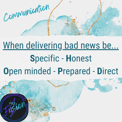Follow us on social media for even more tips!
Business Tips:
Not just Human Resources









Communication
1-know your audience / 2-research if needed, be certain your message is accurate / 3-be ready for questions
Avoid unnecessary filler words Be competent but teachable
Be confident and open to other points of view Include information that is appropriate for your audience
It's ok to text a quick bit of information
Keep it short and to the point
Listen with empathy
Send an email when you want to share a process, or document a conversation
Talk face-to-face for difficult conversations Understand people have different ways of communicating and responding.
Some like to think about what is being discussed, others like to talk it through.
Use facts, figures, and words to express your message clearly
When delivering bad news be… Specific | Honest | Open Minded | Prepared | Direct
Establish Clear Channels: Provide clear channels for communication, such as email, messaging platforms (Slack, Microsoft Teams), project management tools (Trello, Asana), and face-to-face meetings.
Ensure everyone knows how to use these channels effectively.
Encourage Open Communication: Create a culture where employees feel comfortable expressing their thoughts, ideas, and concerns without fear of judgment or reprisal.
Encourage open-door policies and regular feedback sessions.
Active Listening: Encourage active listening among team members.
Ensure that when someone speaks, others listen attentively, ask clarifying questions, and seek to understand their perspective.
Use Plain Language: Avoid jargon, acronyms, or overly technical language that may confuse or alienate team members.
Use plain and straightforward language to ensure clear understanding.
Provide Context: When communicating information, provide context to help others understand the significance and relevance of the message. Context helps prevent misunderstandings and ensures alignment.
Regular Updates: Keep team members informed with regular updates on projects, goals, and company news. This can be done through team meetings, newsletters, or project status reports.
Set Communication Expectations: Establish clear communication expectations, such as response times to emails or messages, and guidelines for using communication tools effectively.
Clarify Roles and Responsibilities: Ensure everyone understands their roles and responsibilities within the team. Clarify who is responsible for what tasks to avoid confusion and duplication of efforts.
Encourage Feedback: Encourage a culture of feedback where team members feel comfortable providing constructive feedback to one another. Feedback should be specific, timely, and focused on improvement.
Embrace Diversity: Respect and value diverse communication styles within the team. Recognize that different individuals may prefer different modes of communication (e.g., email, phone, in-person), and adapt accordingly.
Training and Development: Provide training and resources on effective communication skills, including active listening, conflict resolution, and nonverbal communication. Invest in developing employees' communication abilities.
Lead by Example: Leaders should model effective communication practices by being transparent, approachable, and responsive to their team members. Their behavior sets the tone for communication within the organization.


